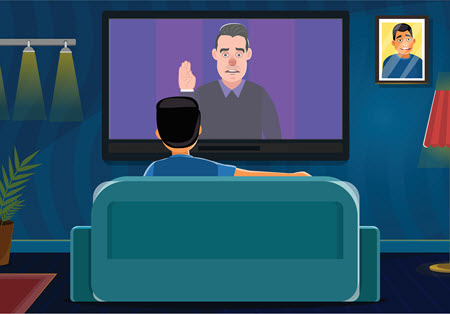Online Service Available for Phobia/Trauma Resolution!
 Phobia elicits fear.
Phobia elicits fear.
The fear of something has been troubling you for some time now. Perhaps it is of getting on a plane, train, or in other enclosed space.
For some unknown reason, you developed a fear of a setting or activity, like going on elevators or going down or up a staircase or escalator.
Phobias often come about after a bad experience, like being bitten by a dog or having a close call with injury or death. They can be related directly or indirectly in some way to that bad experience.
Some people with a phobia do not recall its origin, which is often an early traumatic experience. They’ve just learned to avoid certain situations. Their body is remembering a bad experience that is outside of conscious awareness but comes up as a fear of something.
 Memory of trauma re-emerges in response to triggers.
Memory of trauma re-emerges in response to triggers.
Memories of a bad experience pop into your mind at unexpected times.
You may be a war veteran, a crime victim, or had a disturbing early experience that re-emerges in your conscious mind in ways that feel uncontrolled and unwanted. It can come up as a remembered image, sound, or feeling that triggers other related feelings, images, or sounds.
Mental health professionals call these unwanted and uncontrolled remembrances “flashbacks.”
If you have experienced them, it usually means that you had an intense experience that your primitive brain processed as a threat.
 Phobia and trauma hijack your brain.
Phobia and trauma hijack your brain.
The primitive part of our brain takes over during an experience of perceived threat followed by intense fear. This is described as an Amygdala hijack (https://en.wikipedia.org/wiki/Amygdala_hijack).
The intense emotion during that first experience trained your brain to remember, fear, and avoid that experience and anything reminding you of it.
If you have Post-Traumatic Stress Disorder (PTSD), it means the experience had such an impact that it rewired your brain, causing repeating flashbacks for no apparent reason. It’s like your brain became stuck in the time of the bad memory and can’t seem to move past it.
You may be so affected that you’re not able to get a good night’s sleep. Some are afraid to even try to sleep, fearing repeated nightmares, which is a type of dream flashback. They’re in a hyper-vigilant state with compromised mental and physical health.
 Therapies for phobia and trauma don’t always solve the problem.
Therapies for phobia and trauma don’t always solve the problem.
Many people have tried different types of therapy for these conditions – with mixed results.
Exposure Therapy is often tried for phobias. It involves gradually exposing and desensitizing the person to the thing they are most afraid of until they no longer fear it. It can take months and doesn’t always work. It is often distressing, as it involves reliving the bad experience in higher and higher doses.
Many trauma therapies involve repeated retelling of the traumatic event over a period of months and years and can also be distressing due to the reliving of it.
And they often don’t work in the long term.
 Hypnotherapy provides a bridge over fear to your next level.
Hypnotherapy provides a bridge over fear to your next level.
Hypnotherapy is about locating and unlocking the resources within yourself to overcome the obstacles holding you back in life.
The obstacle often involves fear. Whether it is a simple fear that holds us back, like speaking in public, or a phobia like flying, hypnotherapy unlocks resources that we often don’t realize we already have within us.
Dr. Bob’s specialty is helping adults overcome phobia and trauma, so they can live happier and healthier lives.
Hypnotherapy with V/K Dissociation provides relief without reliving.
What if all of that can be relieved in just a few sessions without exposure, reliving, or retelling?
What if we could rewire your brain so that you no longer suffer from the phobia, and we could end your flashbacks and nightmares, permanently?
Maybe you’ve tried therapy before, but you are still fearful – or you still suffer from traumatic memories flooding back.
Many capable therapists can give support, but they aren’t trained in how to provide immediate symptom relief for phobias or PTSD.
Some professionals will tell you that it takes months or years of work to resolve or even reduce the symptoms of PTSD. You don’t have the time or desire for this painful and difficult work.
Using hypnotherapy, relief in three-to-five sessions is routine.
I’m here to tell you that we can relieve without having you relive those feelings in 5 sessions or less!
Months or years of therapy are not necessary to rid yourself of the symptoms of phobia or PTSD!
In our initial visit, I will describe a technique that works for phobia and PTSD flashbacks called Visual-Kinesthetic dissociation (https://www.researchgate.net/publication/239938915_NLP_and_PTSD_The_Visual-Kinesthetic_Dissociation_Protocol) that rewires your traumatized brain back to a healthy state.
It uses a method that is believed to reconsolidate the memory to other parts of the brain that involve regular non-traumatic memory.
We’ll apply this technique and, if necessary, other hypnotherapy tools that also work just as effectively.
Then we’ll do a post-test to ensure that we got the outcome you wanted – no more ability to trigger a phobic response or flashbacks.
We will wrap it all up in 5 sessions or less so that you can go on to resume a normal life, no longer hampered by phobia or trauma.
And we will do this without having you relive or retell your distressing experience and in complete comfort and safety!
Don’t wait!
We offer a free 20-minute phone consultation. Please call (917) 720-6086 and get started today.
Methods Used for Phobias, Trauma, and Disturbing Memories
Visual-Kinesthetic Dissociation is used for phobia and trauma.
 The treatment is completed in 3-5 sessions and is applied to individual 16 years and older.
The treatment is completed in 3-5 sessions and is applied to individual 16 years and older.
The process consists of the therapist helping the client visualize an image of their younger self on an imaginary screen with a frame around it.
The client is anchored to a safe and secure state and taken through the process of seeing himself in a movie theatre watching his younger self on a movie screen have the past experience that created the trauma or phobia.
This exercise is done 3-5 times until the client can no longer trigger the phobia or traumatic reliving of the event.
Clients report a gradual fade away of the phobia or trauma in question following this intervention.
Eye-Movement Integration also is used for phobia and trauma
 We treat clients ages 16 years and older. Treatment is completed in 3-5 sessions.
We treat clients ages 16 years and older. Treatment is completed in 3-5 sessions.
The process consists of the therapist helping the client, while anchored in a total internal state of safety, imagine they are in a movie theatre watching a movie of their younger self going through the event that caused the phobia or trauma.
When the movie is completed, they are asked to see it freeze framed, while also being asked to follow the therapist’s finger in eye movements crossing the midline of the image back and forth and up and down several times.
The therapist watches their eye movement for indications of stuck points and repeats until no indicators of stuck points remain. Once there appear to be no stuck points, the client is asked to rate the degree of disturbance that the image still has.
The procedure is repeated until the client experiences the image as no longer disturbing to them. Then, they are asked to attempt to trigger their phobia or traumatic remembering.
If they’re unable to remember their phobic or traumatic response, the procedure is completed.
Clients report dissolution of the phobic and traumatic response and inability to bring it back despite being asked to attempt to do so.
Re-imprinting is used for disturbing childhood memories.
 Such memories form the basis of limiting beliefs. After the belief and memory is determined, treatment can be completed in 1-2 sessions. This treatment is provided to the adult population.
Such memories form the basis of limiting beliefs. After the belief and memory is determined, treatment can be completed in 1-2 sessions. This treatment is provided to the adult population.
The client will be aided in identifying a limiting belief that holds them back in some way. They will be helped to find their earliest memory of having the belief.
Then, they will project that scene onto an imaginary screen with a frame around it and will be encouraged to identify the resources both they and the others in that scene lacked that would have resulted in a different conclusion by that client’s younger self.
Once those resources are identified, the client is asked to send them back to his or her younger self as well as the other significant people in the scene.
The scene is then replayed with those resources; and, if still distressing in the client’s view, additional needed resources are sent back until the client reports the result is a different conclusion and meaning to the scene results.
The client is then asked to step into the scene with those added resources that both he and the other person were sent and relives the scene with these changes.
Clients report life-changing differences in their beliefs about themselves and significant figures in their early life, leading to a new understanding of their relationships and of themselves.
Change Personal History is used for any disturbing memories.
 Sometimes individuals have difficulty moving past disturbing memories. Change Personal History treatment is provided for adults and can be completed in 1-2 sessions after the memory is determined.
Sometimes individuals have difficulty moving past disturbing memories. Change Personal History treatment is provided for adults and can be completed in 1-2 sessions after the memory is determined.
The client is asked to identify a memory of an event that continues to bother them or interferes with their daily life in some manner. They’re asked to project the memory onto an imaginary screen and view it from an observer perspective.
Then, they are asked how they would have liked to respond in that situation if they had a chance for a “do over.” Once they identify their desired alternate response, they are asked to identify the needed resources that would have resulted in their having the desired response.
They are then asked to find another context in which they demonstrated the needed resources. They are asked to relive that experience by closing their eyes and traveling back in time to the situation they were in when they had the needed resources.
Once they find that moment and have the needed resources, it is anchored by the therapist, and the anchor is repeated several times as a means of strengthening it. The person is then asked to recall the problem state. Only this time the resource anchor is fired by the therapist, so that the client is triggered into a state of resourcefulness, which is then associated with the problem situation.
The step is repeated several times so that the memory of the problem becomes associated in the client’s mind with their desired state of resourcefulness.
Clients report a changed memory with no further need to go over it.
Psychotherapy is available.
This includes individual 1:1 sessions that are open-ended discussions of any concern, issue, problem, or goal.

